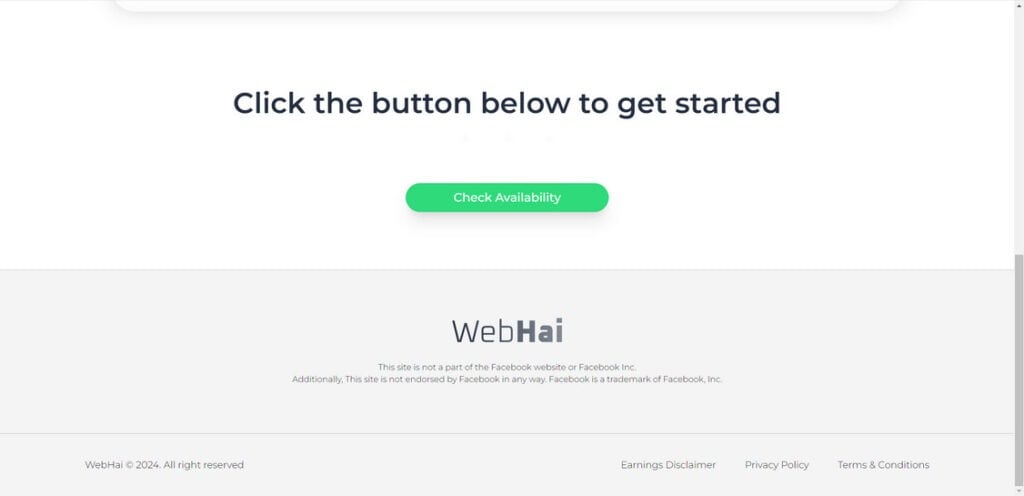WebHai is a scam that has recently exploded in popularity, being heavily promoted on social media platforms like Facebook, Instagram, YouTube, and TikTok. Using fake testimonials and promises of easy money, WebHai aims to convince unsuspecting victims to hand over their personal information and money. In this in-depth article, we will explore how the WebHai scam works, exposing the deceptive marketing tactics they employ. Read on to learn how to identify this scam and protect yourself.

Overview of the WebHai Scam
WebHai is a fraudulent money-making scheme that lures in victims under the pretense of being an artificial intelligence-powered online business platform. This dangerous scam first appeared in late 2023 and has quickly become widespread, utilizing deceptive marketing across mainstream social media platforms to reel in unsuspecting users.
The WebHai scam is centered around an enticing video ad narrated by a paid actor named Jonathan. In this polished, high-production video, Jonathan tells a fictitious rags-to-riches tale about how he achieved financial freedom in record time by using WebHai’s automated online income system.
The ad shows Jonathan going from struggling minimum wage worker to lounging on tropical beaches and buying mansions and luxury vehicles, all thanks to WebHai. This video is a complete fabrication with paid actors, designed to stoke viewers’ desire for an effortless lifestyle change.

Interspersed throughout the ad, specific income claims promise outrageous profits with no work required. Some of the misleading claims state that WebHai users earn an average of $29,589 per month, with top performers making over $100,000 monthly. Images flash of expensive homes, sports cars, and vacations that WebHai supposedly facilitates.
Of course, these extreme income claims have absolutely no basis in reality. But to those unfamiliar with online business, they can be incredibly enticing. This is the hook that sparks interest in potential victims and convinces them to provide their personal information.
When individuals click on WebHai’s video ads, they are directed to the scam company’s main website at WebHai.com. This site utilizes additional deception techniques to further reel in victims.
The WebHai homepage continues the charade with more outlandish income claims plastered in prominent locations. A video loops showing private jets and opulent mansions, perpetuating the myth that WebHai is the key to this elite lifestyle. Fake testimonials throughout the site reference life-changing amounts of money earned.
To build a false sense of urgency, countdown timers and limited-time offers urge visitors to sign up immediately before “spots fill up.” This high-pressure tactic is meant to rush victims into providing personal details and payment, before they have time to properly research the company.
When visitors enter their name, phone number, email address, and other information into online forms on the site, these details go straight into the hands of sophisticated scammers. Innocent users believe they are just signing up to access an amazing money-making artificial intelligence system. But in reality, all they have done is provide scammers with the means to target and defraud them.
The WebHai website exhibits multiple clear markers of being an outright scam operation. The company address provided of 30 SW. Elm Ave. Desoto, TX 75115 does not actually exist, showing WebHai has attempted to conceal its true origins
There is even a completely fabricated Forbes article on the site praising WebHai’s founder Jonathan Williams as the “Best Business Innovator of 2023.” This false endorsement is designed to establish credibility, but a closer look reveals it is total fiction. The article has spelling errors, does not match Forbes’ article style, and cannot be found anywhere else outside the WebHai website.
Perhaps most egregious is that WebHai provides almost no substantive information on how WebHai’s “AI-powered system” actually works. The limited service descriptions are vague, lacking any real technical details or specifics. For an allegedly revolutionary money-making AI, there is zero proof it even exists.
In summary, the WebHai scam’s marketing strategy relies on selling unrealistic dreams of automatic wealth to manipulate potential victims. False promises, fake testimonials, nonexistent addresses, and completely fabricated documents all point to this being an outright criminal enterprise. Those who take the bait by providing their information are putting themselves at immense risk of exploitation by these fraudsters.
This scam has been also investigated by Jordan Liles on his YouTube channel, where he offers a detailed video on the subject. We recommend watching his content for a comprehensive understanding of the scam.
Next, let’s break down exactly how scammers carry out this scam from start to finish.
How the WebHai Scam Works
The way the WebHai scam operates is sophisticated, optimized to extract as much money as possible from victims. Here is a step-by-step look at how this scam ensnares its targets.
Step 1: Initial Contact
The first step of the WebHai scam is making initial contact with potential victims. This is done through social media ads, particularly on Facebook, Instagram, YouTube, and TikTok. These video ads promise outrageous incomes for very little work. Actors portraying satisfied customers give fake testimonials on how WebHai changed their lives.
Intrigued viewers are encouraged to click through to the WebHai.com website, where the deception continues. Flashy videos promise viewers they can “unlock exclusive access” to WebHai and start earning immediately.
Step 2: Collecting User Information
Once on the official WebHai site, viewers are prompted to enter their personal details into online forms, including full name, email address, and phone number.
This information goes directly to the scammers behind WebHai. Email addresses are added to mailing lists for further scam attempts. Phone numbers provide a direct line to contact and manipulate victims.

Step 3: The “Expert” Phone Call
After submitting their information, WebHai victims quickly receive a phone call from a so-called online business expert. These criminals pose as consultants, offering to help victims access and set up WebHai.
The scammers build trust and rave about WebHai’s money-making potential. They claim that for a small fee, usually $67, they can set victims up with WebHai and unlock profit streams.
This phone call is high-pressure, with scammers urging victims to pay the fee as soon as possible. Those reluctant to pay immediately may be called again repeatedly to wear down their resistance.
Step 4: Gaining Remote Access
A key step in WebHai’s scam process is gaining remote access to victims’ devices. The criminals pose as experts who need remote access to “set up” the AI system.
They convince victims to install remote access software like AnyDesk. This allows the scammers to take control of victims’ computers and mobile devices without their knowledge. It also exposes personal files and passwords to theft.
Granting such access gives scammers immense power to extract money. They can stealthily install spyware, access online banking, and steal funds. Victims usually don’t realize what is happening behind the scenes.
Step 5: Extracting More Money
With remote access established, WebHai scammers intensify efforts to siphon money from victims. More sophisticated lies and manipulation tactics are used, tailored to what scammers discover about each victim.
For example, senior victims may be frightened into paying for fake tech support services to remove nonexistent viruses. Younger victims are more likely to keep funneling money into WebHai to unlock promised wealth.
Scammers often keep extracting money until the victim has nothing left to give. Huge credit card debts are common, with interest charges racking up. Retirement savings and home equity are also targeted.
WebHai Victim Stories
To provide further insight into how the WebHai scam impacts real people, below are several anonymous stories collected from those unfortunate enough to get defrauded by this deceitful scheme:
One victim shares their experience after initially signing up for WebHai:
“After opting in, I received a call from an WebHai representative. They asked some questions and claimed they needed their director’s approval to proceed. They called back saying I was tentatively approved, and asked if I had 1.5 hours for them to walk me through the process.
The first thing they asked was for me to download remote access software AnyDesk on my phone. Knowing the risks, I refused to grant that kind of access without knowing more. They became pushy, saying I clearly wasn’t willing to do what it takes. They gave me a number to finish logging in myself and watch some videos.
The limited portal they provided seemed vague with generic tutorials. But they wanted over $250 more for “guaranteed solutions”. I decided to halt and search for reviews before going further.“
Another victim had a similar initial experience:
“After paying the $67 fee, I received an unprofessional call from an WebHai rep. They claimed I was approved and they wanted to begin training using AnyDesk, which I knew was bad news. Despite my repeated discomfort with AnyDesk, they kept insisting it was required. I ultimately refused and asked to call back later before disconnecting.“
A third victim shares their frustrations after realizing they had been scammed:
“WebHai charged me $67 and now I can’t get a refund or reach anyone. They just connect you to more payments. I’ve emailed and texted them to no avail. This is absolutely a scam – don’t fall for it like I did!“
And a final account from someone who avoided getting scammed:
“I saw an WebHai ad and thought I’d try it, but got bad vibes from the countdown timer rushing me. During sign-up my bank wanted a verification code, so I paused. After closing the site I researched the company, which had ties to Cyprus – very sketchy. I canceled my card to be safe. My wife was rightly upset I almost fell for it. If it seems too good to be true, it always is.“
The Scam Continues Under New Names
One insidious aspect of this scam is that the criminals continuously cycle through different names for their imaginary AI system. While WebHai, WebHai Plus and WebHai Line and InfiniteAI have been two of the most heavily promoted variants, do not be fooled if you see this same scam under other titles.


The scam operation behind these fake AI platforms simply produces new marketing videos with changed names whenever one gets exposed and shut down. But the scam itself remains fundamentally the same.
The video ads follow the exact template – a paid actor telling a dubious rags-to-riches tale and promoting unbelievable profits with no work required. The scam website also sticks to the same formula seen with WebHai and InfiniteAI.
Outrageous income claims, fake testimonials, non-existent business addresses, and elaborate ruses to convince victims to pay upfront fees persist from one iteration of the scam to the next.
So remember – even if you see a fresh video ad for some new AI money-making platform, it is almost certainly just a rebranding of this prolific scam. The names change, but the deceptive strategies stay the same. Always exercise extreme caution before providing any personal information or payments in response to such ads.
What To Do if You Are a Victim
If you have fallen prey to the WebHai scam, don’t panic. Here are some steps you can take right away to limit the damage and seek justice:
- Immediately contact your bank and credit card companies: Report any fraudulent charges or suspicious activity. Place holds on accounts the scammers have accessed. This can limit financial loss.
- Change all passwords: If scammers gained remote access to your devices, they may have stolen passwords. Change all passwords as a precaution, starting with your email, online banking, and financial accounts. Enable two-factor authentication wherever possible.
- Scan devices for malware: Remote access software often comes bundled with spyware. Run malware scans using a trusted antivirus program like Malwarebytes to uncover and remove anything malicious. A factory reset may be required on infected devices.
- Contact the FTC: File a scam report with the Federal Trade Commission at ReportFraud.ftc.gov. The FTC tracks down scams like WebHai nationwide.
- Report to the BBB: You can also file reports with the Better Business Bureau to help expose shady business practices. This helps warn other consumers.
- Dispute credit/debit charges: Fight fraudulent WebHai charges with your bank and credit card provider. Provide information on WebHai gathered from government agencies
- Beware follow-up scams: Scammers may pretend to be law enforcement or government agencies to extract more money, claiming they can recover your lost funds. Never pay money to someone claiming they can get your money back.
- Consult with an attorney: If you lost substantial sums, contacting an attorney to review legal options like civil suits may be warranted. An attorney can guide you in reporting the crime.
- Spread awareness: Share your experience online and report the WebHai scam anywhere their ads appear. Post on social media and submit complaints to platforms like Facebook. This helps protect other potential victims.
- Seek emotional support: Being defrauded can be devastating. Seek support from trusted friends and family. Speaking with a counselor or therapist can also help you process the emotions and stress.
How to Spot These AI Scams
While the scammers may change the name of their imaginary AI software, there are consistent red flags you can watch for to avoid being defrauded. Here are key signs an advertised AI business opportunity is a scam:
- Promises automatic/easy passive income – Real AI requires ongoing work and optimization, not hands-off profits. Beware opportunities promising you can just “set and forget” an AI to make you rich.
- Fake testimonials and income claims – Verify testimonials by searching online. Outlandish profits are a giveaway something is amiss.
- High-pressure sales tactics – Countdown timers, limited spots, etc. are used to prevent you from properly vetting the company.
- Vague about the AI technology – Legitimate AI businesses can explain how their tech works. Lack of details suggests it’s all buzzwords.
- No proven business track record – Scams rely entirely on hype. Established AI companies will have a history you can research.
- Dodgy contact info/addresses – Fake addresses and non-working phone numbers are common scam red flags.
The most crucial step is simply taking time to thoroughly research any AI business opportunity before providing payment or personal details. Avoid instantly trusting slick marketing materials. Protect yourself by proactively looking for warning signs of a scam.
Frequently Asked Questions About the WebHai Scam
1. What exactly is WebHai?
WebHai is a fraudulent scam operation that pretends to be an artificial intelligence-powered system for earning money online. Using deceptive marketing tactics, WebHai aims to trick social media users into handing over money and personal information.
2. How does the WebHai scam work?
The WebHai scam works by first targeting potential victims through social media ads on platforms like Facebook, Instagram, and YouTube. These video ads portray a man named Jonathan who claims he got rich quick using WebHai’s automated online business tools.
Intrigued viewers then visit the WebHai.com website, where they are pressured into providing personal details under the guise of signing up for access to WebHai. Once users submit their information, WebHai scammers call them posing as account managers and persuade victims to pay fees to set up their account.
3. What techniques does WebHai use to deceive people?
WebHai relies heavily on deception to perpetrate its scam. Some of the most common techniques include:
- Fake income claims of making over $29,000 per month
- Countdown timers and limited-time offers to rush victims
- Completely fabricated Forbes article endorsing the company
- Nonexistent business address to hide origins
- False testimonials throughout their website
- Vague descriptions of the AI services offered
3. How much does WebHai cost?
WebHai scammers aim to extract as much money as possible from victims. Initial fees are typically around $67 to “set up” accounts. But through high-pressure manipulation tactics, these criminals often coerce victims into paying hundreds or thousands more.
5. Is WebHai real artificial intelligence?
No. Despite claims of being an advanced AI system, WebHai has no real artificial intelligence capabilities whatsoever. The talk of AI is simply a ruse to make the scam appear high-tech and legitimate. There is no proof any actual AI technology exists.
6. Can WebHai really make people rich online?
Absolutely not. WebHai’s promises of making thousands or tens of thousands per month are completely fictitious. There is no evidence anyone has ever earned money with WebHai, because no actual system exists. The income claims are false bait to lure in victims.
7. Is WebHai legal?
No. WebHai is an outright scam operation that uses deception and manipulation to defraud consumers. State and federal agencies like the FTC consider such scams to be illegal acts punishable under law.
8. How can I avoid WebHai scams?
The best way to avoid WebHai is to be wary of any opportunity promising easy passive income online. Check for warning signs like fake testimonials, countdown timers, and too-good-to-be-true claims. Research any company thoroughly before paying fees or providing personal information.
9. What should I do if WebHai scammers contact me?
Do not pay them any money or give them your personal information. End communication immediately and report them to the FTC. Warn friends and family about the scam. Contact social media platforms to have WebHai ads removed.
10. Where can victims report this scam?
If you are a victim of the WebHai scam, you can report it to the Federal Trade Commission, state attorneys general, and the Better Business Bureau. File a complaint so legal action can be taken against the criminals behind WebHai.
The Bottom Line
In summary, WebHai is an extremely deceptive scam operation that targets victims through social media platforms. Using videos full of fake testimonials and income claims, WebHai convinces people to submit their personal information under the guise of a risk-free AI business opportunity that will make them rich quick.
However, the realities of WebHai are anything but risk-free. Victims are pressured into handing over money and allowing remote access to their devices. From there, professional scammers employ manipulation and theft to siphon as much money as possible, often ruining victims financially and emotionally.
There are no shortcuts to building real wealth online. Any opportunity that promises immediate, effortless riches with no risk simply does not exist – WebHai included. Avoid falling for this scam by understanding the deceptive strategies they utilize. And if you or a loved one has been victimized, take proactive steps to limit damage, report the fraud, and seek justice.
Educating yourself is the best defense against online scams. Share your knowledge and caution others, especially elderly individuals vulnerable to schemes like WebHai promoted through social media. With awareness and vigilance, we can work together to eventually shut down harmful criminal operations like WebHai for good.
This article is for educational purposes only and does not constitute professional, financial or legal advice. The content is intended for general information and should not be construed as definitive guidance. Information contained herein is subject to change without notice. For concerns, please contact us via the provided form. If you are the owner of the website or product in question and wish to offer clarifications regarding your business or website, please reach out to us through the provided Contact Form.










